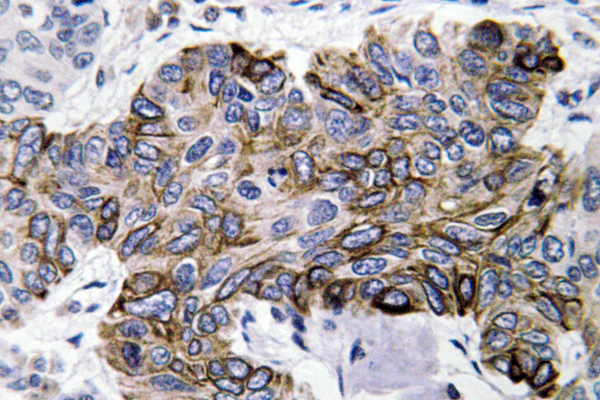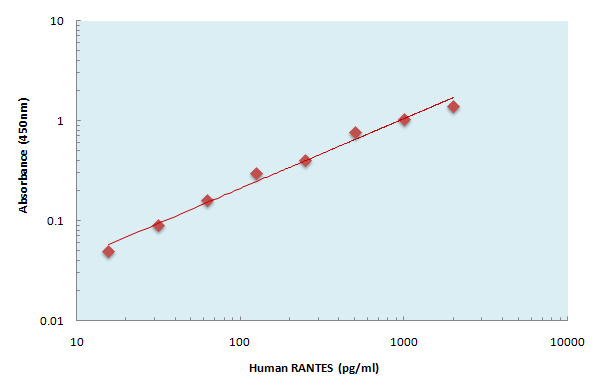RANTES Polyclonal Antibody
- Catalog No.:YT4002
- Applications:IHC;IF;ELISA
- Reactivity:Human;Mouse;Rat
- Target:
- RANTES
- Fields:
- >>Cytokine-cytokine receptor interaction;>>Viral protein interaction with cytokine and cytokine receptor;>>Chemokine signaling pathway;>>Toll-like receptor signaling pathway;>>NOD-like receptor signaling pathway;>>Cytosolic DNA-sensing pathway;>>TNF signaling pathway;>>Prion disease;>>Epithelial cell signaling in Helicobacter pylori infection;>>Shigellosis;>>Chagas disease;>>Human cytomegalovirus infection;>>Influenza A;>>Herpes simplex virus 1 infection;>>Rheumatoid arthritis;>>Lipid and atherosclerosis
- Gene Name:
- CCL5
- Protein Name:
- C-C motif chemokine 5
- Human Gene Id:
- 6352
- Human Swiss Prot No:
- P13501
- Mouse Gene Id:
- 20304
- Mouse Swiss Prot No:
- P30882
- Rat Swiss Prot No:
- P50231
- Immunogen:
- The antiserum was produced against synthesized peptide derived from human RANTES. AA range:35-84
- Specificity:
- RANTES Polyclonal Antibody detects endogenous levels of RANTES protein.
- Formulation:
- Liquid in PBS containing 50% glycerol, 0.5% BSA and 0.02% sodium azide.
- Source:
- Polyclonal, Rabbit,IgG
- Dilution:
- IHC 1:100 - 1:300. ELISA: 1:40000.. IF 1:50-200
- Purification:
- The antibody was affinity-purified from rabbit antiserum by affinity-chromatography using epitope-specific immunogen.
- Concentration:
- 1 mg/ml
- Storage Stability:
- -15°C to -25°C/1 year(Do not lower than -25°C)
- Other Name:
- CCL5;D17S136E;SCYA5;C-C motif chemokine 5;EoCP;Eosinophil chemotactic cytokine;SIS-delta;Small-inducible cytokine A5;T cell-specific protein P228;TCP228;T-cell-specific protein RANTES
- Molecular Weight(Da):
- 10kD
- Background:
- This gene is one of several chemokine genes clustered on the q-arm of chromosome 17. Chemokines form a superfamily of secreted proteins involved in immunoregulatory and inflammatory processes. The superfamily is divided into four subfamilies based on the arrangement of the N-terminal cysteine residues of the mature peptide. This chemokine, a member of the CC subfamily, functions as a chemoattractant for blood monocytes, memory T helper cells and eosinophils. It causes the release of histamine from basophils and activates eosinophils. This cytokine is one of the major HIV-suppressive factors produced by CD8+ cells. It functions as one of the natural ligands for the chemokine receptor chemokine (C-C motif) receptor 5 (CCR5), and it suppresses in vitro replication of the R5 strains of HIV-1, which use CCR5 as a coreceptor. Alternative splicing results in multiple transcript variants that encode
- Function:
- function:Chemoattractant for blood monocytes, memory T-helper cells and eosinophils. Causes the release of histamine from basophils and activates eosinophils. Binds to CCR1, CCR3, CCR4 and CCR5. One of the major HIV-suppressive factors produced by CD8+ T-cells. Recombinant RANTES protein induces a dose-dependent inhibition of different strains of HIV-1, HIV-2, and simian immunodeficiency virus (SIV). The processed form RANTES(3-68) acts as a natural chemotaxis inhibitor and is a more potent inhibitor of HIV-1-infection. The second processed form RANTES(4-68) exhibits reduced chemotactic and HIV-suppressive activity compared with RANTES(1-68) and RANTES(3-68) and is generated by an unidentified enzyme associated with monocytes and neutrophils.,induction:By mitogens.,mass spectrometry: PubMed:1380064,mass spectrometry: PubMed:15923218,mass spectrometry:O-glycosylated PubMed:1380064,online
- Subcellular Location:
- Secreted.
- Expression:
- Expressed in the follicular fluid (at protein level). T-cell and macrophage specific.
HUCMSC-derived Exosomes Suppress the Titanium Particles-induced Osteolysis in Mice through Inhibiting CCL2 and CCL3 Orthopaedic Surgery Yue Ding MD IHC Human hip Synovial membrane
- June 19-2018
- WESTERN IMMUNOBLOTTING PROTOCOL
- June 19-2018
- IMMUNOHISTOCHEMISTRY-PARAFFIN PROTOCOL
- June 19-2018
- IMMUNOFLUORESCENCE PROTOCOL
- September 08-2020
- FLOW-CYTOMEYRT-PROTOCOL
- May 20-2022
- Cell-Based ELISA│解您多样本WB检测之困扰
- July 13-2018
- CELL-BASED-ELISA-PROTOCOL-FOR-ACETYL-PROTEIN
- July 13-2018
- CELL-BASED-ELISA-PROTOCOL-FOR-PHOSPHO-PROTEIN
- July 13-2018
- Antibody-FAQs
- Products Images

- Immunohistochemistry analysis of RANTES antibody in paraffin-embedded human lung carcinoma tissue.



